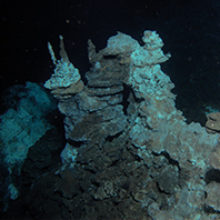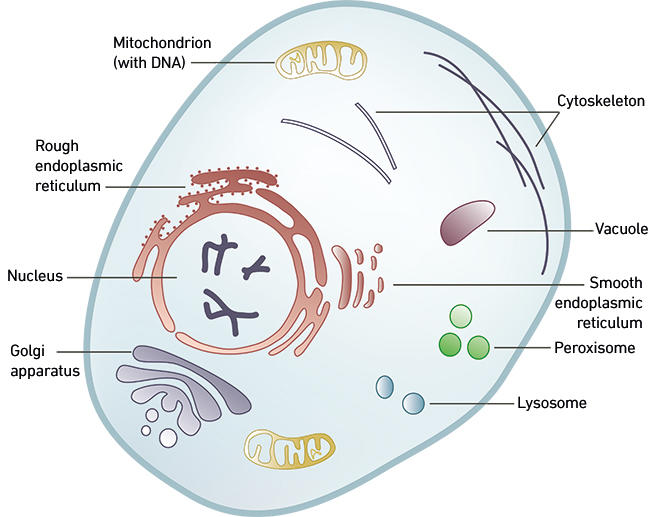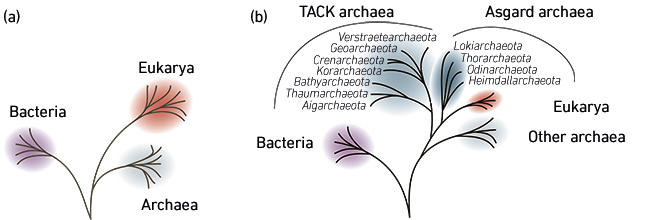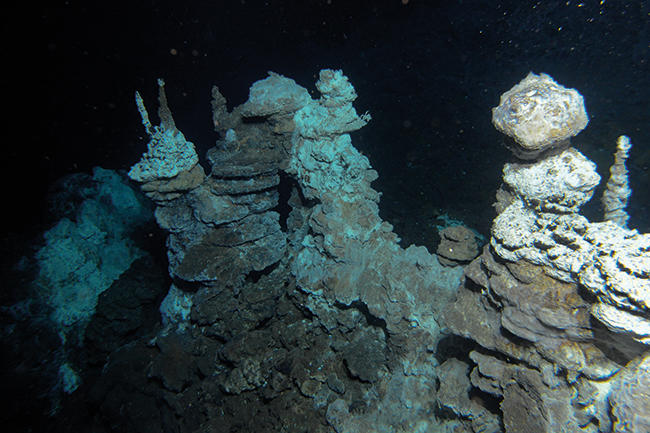What Structural Feature Of Prokaryotic Cells Changed Before Endosymbionts

All cellular life on Earth tin can be classified into one of the three domains: bacteria, archaea or eukaryotes. Whereas cells of bacteria and archaea are small and simple, those of eukaryotes are by and large bigger and circuitous, containing a nucleus that encompasses DNA, and other subcellular compartments, referred to equally organelles.
There is evidence that eukaryotic cells arose during evolution from a merger of less complex cells, through a process called endosymbiosis. Contempo findings accept provided exciting insights into the primary players in this enigmatic symbiosis that was responsible for the emergence of all complex life forms on our planet.
A eukaryotic potpourri
Leaner and archaea are known collectively as 'prokaryotes' (from the Greek: pro = before, karyon = nucleus), equally their genetic material is not enclosed past a nuclear membrane. In addition, prokaryotic cells are mostly 'unproblematic': they are small, single-celled organisms (typically between 0.5 and 5 microns in diameter) with a cell wall and a small-scale circular chromosome. Eukaryotic cells (from the Greek: eu = truthful, karyon = nucleus) on the other paw are a potpourri: they can exist much bigger (generally between 10 and 500 microns), and comprise a diversity of specialised compartments, of which the nucleus houses the genomic DNA and is the authentication. Other compartments include, for example, the mitochondria (best known equally the 'power-house' of the cell, where energy production occurs), and a sophisticated endomembrane system (Fig. 1). Among evolutionary biologists, the question of how these eukaryotic cells and their circuitous features evolved has been the subject of heated debate for decades.
Fig. 1. A typical eukaryotic cell and its complex subcellular arrangement.

A symbiotic origin of eukaryotes?
The observation that eukaryotic cells are compartmentalised was made a long time ago. Konstantin Mereschkowski (1855–1921) noticed certain structural similarities between plant chloroplasts (the organelles in which photosynthesis occurs) and unicellular blue-green alga, a group of photosynthetic bacteria. In 1910, he proposed that the onetime evolved from the latter, as the result of endosymbiosis. This refers to a process by which a cell lives within another later being engulfed and establishes a long-term association with its host. In the 1960s, the idea that endosymbiosis might have played a pivotal part in eukaryotic evolution was re-popularised by Lynn Margulis. She proposed that, apart from chloroplasts, mitochondria likewise evolved from trapped free-living bacteria. The scientific customs initially dismissed Margulis' ideas. But when it was discovered that mitochondria and chloroplasts contained their own genetic material that turned out to be related to that of bacteria, support for the endosymbiosis theory finally gained momentum. In particular, mitochondria were found to descend from a bacterial group known as the Alphaproteobacteria. These bacteria are usually gratuitous-living, but some can engage in symbioses with eukaryotic organisms. Symbiotic interactions are common do in the microbial world, merely alphaproteobacteria seem to be especially good at this. In light of this, information technology is perhaps not also surprising that mitochondria have an alphaproteobacterial ancestry.
Engulfed by speculation
Whereas the alphaproteobacterial identity of the mitochondrial antecedent has been known since the 1980s, the nature of the jail cell that engulfed them (the host prison cell) has remained elusive. Ever since Carl Woese and co-workers discovered the archaea in the 1970s, it was articulate that the host cell was somehow related to these organisms – but how exactly was unclear. According to the view that was prevailing upwardly to the 2000s, archaea and eukaryotes represented sister, but separate, groups in the tree of life (Fig. 2a). This view is most uniform with scenarios in which many of the cellular features that define eukaryotes evolved prior to the mitochondrial endosymbiosis. The host cell, in these scenarios, was thus a circuitous 'proto-eukaryote' that virtually likely engulfed the mitochondrial endosymbiont using phagocytosis – an energy-demanding ingestion process merely known to exist in eukaryotic organisms.
Who's your (archaeal) daddy?
In dissimilarity, other scenarios have suggested the fusion of a 'normal' archaeon with an alphaproteobacterium. In fact, they proposed that the mitochondrial endosymbiosis was the outset upshot at the origin of eukaryotic cells: the burst of energy provided by mitochondria and then allowed the elaboration of the complex features that are characteristic of eukaryotes, including phagocytosis. These models posed that the archaeal partner and the mitochondrial progenitor engaged in a syntrophic interaction – a symbiosis based on exchange of nutrients that is mutually beneficial. In time, this syntrophy became more than intimate, culminating in the engulfment of the mitochondrial progenitor by the archaeal host prison cell. All the same, these so-called symbiogenic models for the origin of eukaryotes presented several problems. First, they unsaid that eukaryotes evolved from a bona fide archaeon, and not equally a sister group of all archaea, which was at odds with the by and large accustomed topology of the tree of life. In addition, how did the endosymbiont end up within the archaeal host cell if the process of phagocytosis evolved later? Finally, a third problem concerns cell membranes: eukaryotic membranes are radically unlike from archaeal ones, and in fact resemble bacterial membranes. Whereas the membranes of archaeal cells are comprised of isoprene-based lipids, eukaryotic membranes are similar to those of bacteria, which are made upwards of lipids with fatty acid chains. Hence, if eukaryotes evolved from an archaeon, how can their membranes contain bacterial-type lipids?
Fig. 2. Two main competing hypotheses regarding the origin of eukaryotes. (a) Eukaryotes and Archaea were long believed to exist contained sis groups. (b) Eukaryotes are at present thought to descend from an archaeon. Their closest known relatives are Asgard archaea (Lokiarchaeota-related archaea).

A paradigm gets shifty
For a long time, hypotheses for the origin of eukaryotes were mostly based on cytological observations, and, in the 1980–90s, on express amounts of available molecular (sequence) information. This all started to change in the genomic era, when newly adult genome sequencing technologies fabricated it possible to perform genome-wide studies to investigate eukaryotic origins. Intriguingly, such studies brought about a paradigm shift: efforts to reconstruct the tree of life started to reveal a movie in which eukaryotes emerged from within the archaeal domain (Fig. 2b). In particular, eukaryotes were establish to grouping together with the 'TACK' archaea, a group of diverse archaeal species, which seemingly contain a number of genes that they uniquely share with eukaryotes. These observations were in support of some symbiogenic models for the origin of eukaryotes, which invoked a TACK-related archaeal host cell and an alphaproteobacterial endosymbiont. However, amid the TACK archaea, scientists were not able to pinpoint a specific lineage as being more closely related to eukaryotes than the others.
Our microbial ancestry finally revealed
Recently, this story got an unexpected twist. In 2015, a new group of archaea was discovered in deep-sea floor sediments of the Mid-Atlantic Ridge, shut to a hydrothermal vent organization known as Loki's Castle (Fig. iii). By sequencing Deoxyribonucleic acid that was isolated directly from these sediments, we obtained genomic data for a new archaeal grouping, which we named 'Lokiarchaeota' – or 'Loki' for short. Fascinatingly, non but did Loki appear to be the closest relative of eukaryotes in the tree of life, simply its genome contained a multitude of genes that were only known to exist in eukaryotes. Amidst these genes were those that play an important function in eukaryotic prison cell biology – genes that, in a fashion, make the essence of a eukaryote. Yet, apart from these eukaryotic-like genes, Loki seems to exist a typical archaeon. In fact, the role of these genes in Loki is still a mystery. Fifty-fifty more recently, nosotros discovered additional Loki-related archaea and named them subsequently other Norse gods (Thor, Heimdall and Odin); they all comprise a large number of 'eukaryotic' genes. These discoveries reinforce the idea that eukaryotes have an archaeal beginnings, and that these ancestors were perhaps 'primed' to go circuitous. Hereafter studies focusing on elucidating the prison cell biology and physiology of our closest prokaryotic relatives will likely reveal important clues about how, billions of years ago, circuitous eukaryotic cells evolved from the much simpler archaeal cells.
Fig. iii. Image of a hydrothermal vent field along the Arctic Mid-Body of water Ridge, close to where 'Loki' was found in marine sediments. The hydrothermal vent system was discovered by researchers from the Middle for Geobiology at the University of Bergen, Norway.

Laura Eme & Thijs J. G. Ettema
Uppsala University, Box 596, SE-75 123 Uppsala, Sweden
[email protected]
Further reading
Spang, A. & others (2015). Complex archaea that span the gap between prokaryotes and eukaryotes. Nature 521, 173–179.
Zaremba-Niedzwiedzka, K. & others (2017).Asgard archaea illuminate the origin of eukaryotic cellular complication. Nature 541, 353–358.
López-García, P., Eme, L. & Moreira, D. (2017). Symbiosis in eukaryotic development. J Theor Biol. doi:10.1016/j.jtbi.2017.02.031.
Images: Figs. 1 and 2.Both Fifty. Eme.Fig. 3.R. B. Pedersen, Centre for Geobiology, University of Bergen (Norway).
Source: https://microbiologysociety.org/publication/past-issues/archaea/article/the-symbiosis-that-changed-the-world.html
Posted by: kempaffins.blogspot.com


0 Response to "What Structural Feature Of Prokaryotic Cells Changed Before Endosymbionts"
Post a Comment